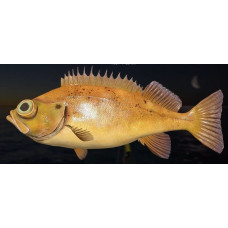Latin name
Sebastes mentella
Other names
Deepwater redfin, ocean perch, Atlantic redfish, Norway haddock, red perch, golden redfish, hemdurgan
Identification
Massive body covered with ctenoid scales. Numerous spines and ridges are poorly developed on the head. The occipital and nuchal ridges are fused. The head is large. The eyes are large, the diameter of the orbit is 27.5-29.5% of the length of the head. The lower jaw is prominent with a very large symphysial tubercle. The interorbital space is flat or slightly convex. Long dorsal fin with 13-17 (usually 14-15) barb rays and 13-16 soft rays. The anal fin has 3 barb rays and 7-11 (usually 9) soft rays. Pectoral fin with 18-20 soft rays. The caudal fin is truncated. Lateral line with 32-40 (usually 34) scales. Vertebrae 30-32.
Fish colouring
Body, head and fins bright red, belly pink.
Distribution
Widespread in the North Atlantic and Arctic Oceans: western Barents Sea to 35° E, off western Svalbard, Greenland Sea, Norwegian Sea, off the coast of northern Norway, around Iceland and the Faroe Islands; off the coast of eastern and western Greenland; off the east coast of Labrador and Baffin Land; Baffin Sea, Irminger Sea, Labrador Sea; south along the coast of North America to Cabot Strait and Long Island.
Habitat
Marine gregarious benthic and mesopelagic fishes. They form large aggregations in both the bottom and middle layers of water at depths of 300 to 1441 metres.
Size
Maximum length 77.5 cm, usually up to 40 cm.
Behavior
They make seasonal, feeding and spawning migrations. Life expectancy is up to 75 years.
Food and feeding habits
Adults are characterised by a broad dietary spectrum. In the stomachs, 24 taxa of animals belonging to 11 systematic groups of invertebrates and fish were found. The diet includes amphipods, copepods, euphausiids, shrimps, juvenile squid and various fish species. Among the fish, Myctophum punctatum and Bentozema glaciale were the dominant prey. Fish of the families Paralepididae, Gonostomatidae, Chauliodontidae, Sternoptychidae, Bathylagidae, Nimichthyidae and their juveniles were also found. Seasonal variability in spectrum and feeding activity was observed. The lowest feeding activity was observed in April-May. At this time the diet is dominated by copepods, euphausiids and shrimps. During the summer months, the feeding intensity increases and the role of amphipods, juvenile squid and fish increases. At the same time, mass cannibalism is observed. In autumn, the proportion of cephalopods and fish increases. Fish continue to feed actively until October.
Reproduction
It is an oviparous species with internal fertilisation. Mating usually takes place at depths greater than 500 metres: North Atlantic: August - October; of Iceland: October - December; Arctic Ocean: September - October; Labrador Sea and Irminger Sea: September - early October. After mating, the sperm is retained in the female for several months until the eggs are fertilised. The eggs hatch inside the female. Larval hatching occurs at different times of the year in different parts of the range: on the Flemish Cap Bank and in the Norwegian Sea, larvae hatch from mid-March to early May; in the Irminger Sea, from April to late May; in the Barents Sea, from May to July; in the Newfoundland area and on the Great Newfoundland Bank, from March to August.
Fishing
Valuable commercial fish.
| Classification | |
| Phylum | Chordata |
| Class | Actinopterygii |
| Squad | Scorpaeniformes |
| Family | Scorpaenidae |
| Genus | Sebastes |
| Species | S. mentella |
| Features | |
| Conservation status | Least Concern |
| Habitat | Pelagic |
| Life span, years | 75 |
| Maximum body weight, kg | No information |
| Maximum length, cm | 77,5 |
| Sailing speed, m/s | No information |
| Threat to people | Edible |
| Way of eating | Predator |
Beaked redfish
Tags: beaked redfish

